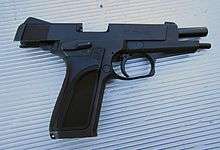Browning BDM
The Browning BDM is a semi-automatic pistol designed and manufactured by the Browning Arms Company from 1991 until production ceased in 1998. Similar in appearance to Browning's (FN Herstal) P-35 model "Hi-Power" pistol, the BDM was actually a new design created to compete in service trials for a proposal as a standard issue pistol for the United States Federal Bureau of Investigation (FBI). However, the BDM was ultimately not adopted for purchase and issue by the FBI, so was instead sold only in the commercial market.
| Browning BDM | |
|---|---|
 A Browning BDM with the slide open. | |
| Type | Semi-automatic pistol |
| Place of origin | United States |
| Production history | |
| Designer | Browning Arms Company |
| Designed | 1991 |
| Manufacturer | Browning Arms Company |
| Produced | 1991 - 1998 |
| Variants | BPM-D and BRM-DAO |
| Specifications | |
| Mass |
|
| Barrel length | 120 mm/4.7 in |
| Cartridge | 9×19mm Parabellum |
| Feed system | Detachable 15-round box magazines |
Design
The Browning BDM was developed in 1991 by the Browning Arms Company, and unlike Browning's (FN Herstal) P-35 Hi-Power model, was manufactured only in North America, in Utah and Montreal. Having a similar profile to the Browning P-35 Hi-Power, the BDM and its variants are often conflated as mere variants of the much older P-35 model, or other newer Browning or FN Herstal pistols that were updated variants of the P-35, such as the Hi-Power DAO.
The BDM pistol is a magazine-fed, self-loading, hammer-firing type which was designed with a trigger "mode" switch installed on the left-hand side of the slide (actually only a flush inlaid disk with a bisecting groove), toggling between double-action/single-action (DA/SA) pistol mode, and the double-action-only (DAO) or "revolver" mode—though, of course, other than the similarity of the trigger mode, the BDM has no resemblance to revolvers. This mode switch is what gives the handgun its name, with BDM standing for "Browning Dual Mode" or "Browning Double Mode".
Variants of the BDM lacked the mode operating switch, and so were either full-time "revolver" mode, such as the model BRM-DAO (Browning Revolver Mode - Double Action Only), or full-time double-action/single-action pistol mode, model BPM-D (Browning Pistol Mode - Decocker). Finishes included blued, matte-chromed (which Browning advertising called "silver chrome"), and a two-toned combination of a silver chromed frame and blued slide, called the "practical" finish.
The BDM and BPM-D variant have an ambidextrous frame-mounted safety/decocker lever, which when operated returns the pistol to the hammer-down, pre-cocked "safe" condition. Unless the hammer is manually pulled rearward into the cocked position, the usual first shot of a series requires only a relatively longer and heavier double-action trigger pull. Each subsequent cartridge can then be fired by a lighter, shorter single-action trigger pull, until the hammer is reset to the down and "safe" position by depressing the safety/decocker lever.
The BRM-DAO variant lacks a safety/decocker lever, returning the hammer to the down and "safe" position after every shot fired. Operating the trigger of the BRM-DAO variant is the same as operating the double-action trigger pull (usually the first round fired of a series) of the BDM and BPM-D models. However, because the hammer of the BRM-DAO model automatically returns to the down and "safe" condition after every shot, the BRM-DAO is a full-time "double-action only" (DAO) pistol. All trigger pulls for the BRM-DAO are essentially consistent.
The BDM and its variants utilize within the pistol's grip a removable box magazine, of the double-stack variety with a capacity of 10 or 15 rounds of 9×19mm Parabellum ammunition. To comply with the 1994 U.S. Assault Weapons legislation, BDM magazines were initially limited to 10-round capacity for civilian purchasers, although 15-round magazines were available for law enforcement use. After the 2004 expiration of the 1994 U.S. Assault Weapons legislation, 15-round magazines became legal and available in most states for civilian use.
The Browning BDM, BPM-D, and BRM-DAO were noted for being among the narrowest full-sized 9x19mm pistols ever manufactured (even more narrow than the Browning or FN Herstal Hi-Power models) which made them easier to conceal and to operate by persons with smaller hands.
References
- Martin J. Dougherty: Pistols and Revolvers: From 1400 to the present day, Amber Books Ltd, 2017, S. 181, ISBN 978-1-78274-266-1.
- Clapp, Wiley: The Browning BDM: A Gem That Never Sparkled, https://www.shootingillustrated.com/articles/2019/5/16/the-browning-bdm-a-gem-that-never-sparkled/
| Wikimedia Commons has media related to Browning BDM. |